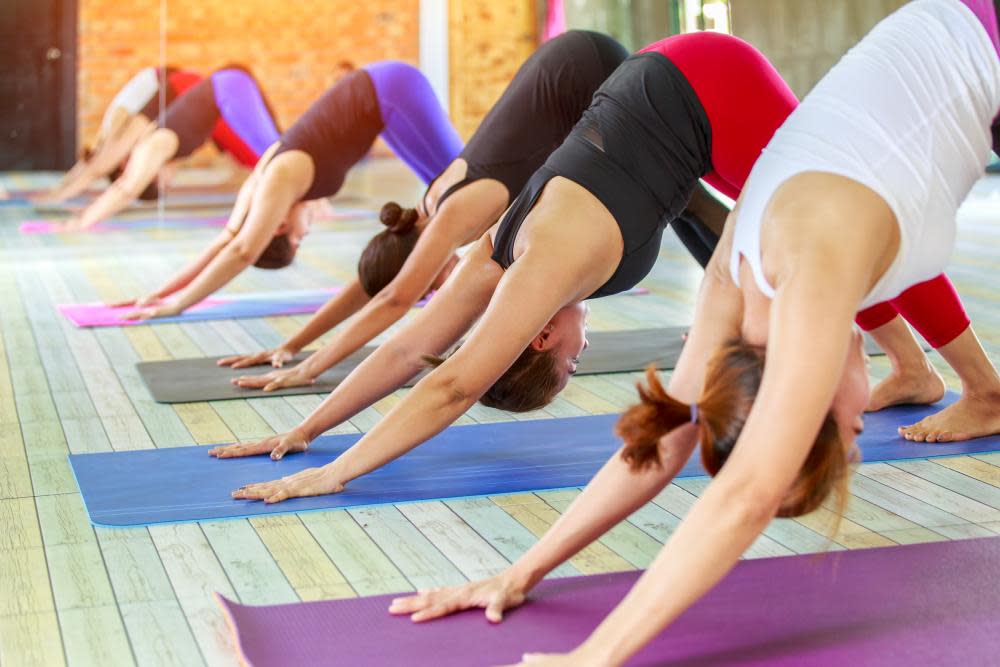Touching in yoga is touchy indeed – and it should be

Despite what Instagram – with its abundance of sexy, gorgeous and limber influencers – might have you believe, yoga is not a sexual practice. The true practice has one goal: to calm the fluctuations in the mind. In other words, authentic yoga is the very opposite of the cluttered and hedonistic space yoga currently occupies for many.
My mother was a yoga teacher before it was cool, back in the 1980s when moms like mine made us eat carob instead of chocolate and kept photos of their gurus on altars surrounded by beads, dried flowers and brass renderings of Shiva and Ganesh. My mother’s guru – and by extension, my childhood guru – was Amrit Desai, who later resigned from the Kripalu Center in the Berkshires in disgrace after his proclaimed celibacy was discovered to be a lie. He is one of a number of gurus who have suffered minor or major falls from grace, including Pattabhi Jois of the Ashtanga lineage and Bikram Choudhury of Bikram yoga.
Yoga is having a long overdue “me too” moment. Last week Katherine Rosman, a reporter for the New York Times, published an exposé on the problems around “physical adjustments” in yoga class. In a physical adjustment, a teacher uses their hands to help guide a student more deeply into a posture. They can be done in almost any pose and different teachers have different methods. According to the piece, these touches are often unwanted. They can also be dangerous, if a student is modifying due to injury and a teacher pushes them too far, or psychologically triggering, for people recovering from trauma.
I became a yoga teacher almost 10 years ago. I discovered that the world of yoga had changed dramatically since my mother’s days as a barefoot hippie in white sweatpants. Hundred-dollar leggings are the norm and women doing handstands on beaches in impossibly skimpy bikinis sell granola bars on Instagram to millions of followers. The question of what yoga is or isn’t has become muddled, indeed.
My first 200 hours spent in yoga teacher training focused far more on the postures and the sutras, which are, essentially, the Sanskrit rules to living a yogic life. I graduated feeling deeply committed to my personal practice, but lacking the basic skills of teaching. My second 200-hour training was at Lifetime Yoga, where the teachings of Jonny Kest, one of the teachers highlighted by the Times, are used to teach a vigorous hot vinyasa flow. Vinyasa is a touch-heavy practice. We spent hours learning techniques to physically adjust our students. We were encouraged to help deepen postures by giving mini massages and finding press points to help students find greater ease in postures. Physical adjustments are generally an accepted part of any practice. But Kest’s approach, as highlighted by the Times, is controversial because, until this recent backlash, it didn’t include consent.
Different studios handle consent differently. At my current studio outside London, we use place cards in front of our mats saying whether or not we wanted to be touched. One of my teachers asks us to place hands on our bellies in savasana (corpse pose) if we prefer not to be touched. Consent is vital. When touch feels good, it feels so good. When it feels bad, it’s awful.
This is something I learned the hard way. I once had to go to a yoga class three times before I figured out that the way my male teacher was parting my thighs from behind and rubbing his groin into my backside was inappropriate. I should have known better, but that’s the inherent trouble with yoga. Part of the teacher/student relationship is trust and no one should practice with a teacher they don’t trust.
Last year, I had to stop adjusting men I don’t personally know in my classes. Twice I was cornered after an evening class by men making advances on me. It’s easy to mistake the caring touch of a yoga teacher for something more sexual – especially if that touch hasn’t been adequately explained to students.
Another teacher I know was stalked by a student for months because he mistook her adjustment for a sexual pass. In training, I was told to be cautious with touch, especially on straight men. Touch is, after all, the “mother of all senses”. In a fetus, it is the first sense we develop. Touch can be especially confusing for men because, as psychologist Ofer Zur points out, “For most men in our society, touch has been limited to violent and sexual encounters.”
For all these reasons, I believe yoga studios have a responsibility to define and explain the purpose of touch to every student who walks in their door. We can’t play fast and loose with consent.
Touch is a potentially beautiful thing. It can help relax a body and deepen a posture. But until every single yoga studio nails consent, touching in yoga ought to be touchy, indeed.

